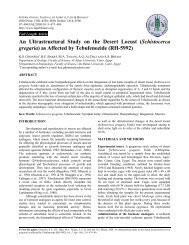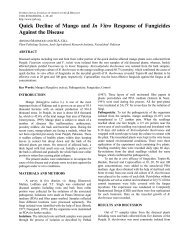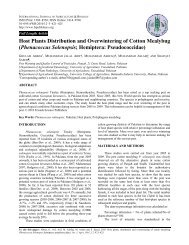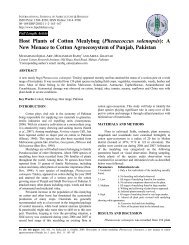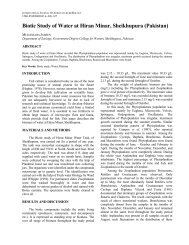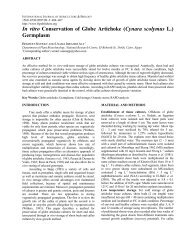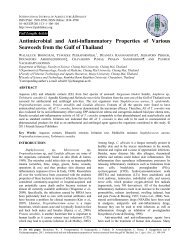Yield and Water Use Efficiency of Pear Trees ... - Fspublishers.org
Yield and Water Use Efficiency of Pear Trees ... - Fspublishers.org
Yield and Water Use Efficiency of Pear Trees ... - Fspublishers.org
You also want an ePaper? Increase the reach of your titles
YUMPU automatically turns print PDFs into web optimized ePapers that Google loves.
INTERNATIONAL JOURNAL OF AGRICULTURE & BIOLOGY<br />
ISSN Print: 1560–8530; ISSN Online: 1814–9596<br />
12–162/AWB/2012/14–6–887–893<br />
http://www.fspublishers.<strong>org</strong><br />
Full Length Article<br />
<strong>Yield</strong> <strong>and</strong> <strong>Water</strong> <strong>Use</strong> <strong>Efficiency</strong> <strong>of</strong> <strong>Pear</strong> <strong>Trees</strong> under Drip<br />
Irrigation with Different Surface Wetted Percentages<br />
ZHI ZHAO, WEI WANG 1 †, YANG WU AND XINGFA HUANG 1<br />
College <strong>of</strong> <strong>Water</strong> Resources <strong>and</strong> Civil Engineering, China Agricultural University, 100083, Beijing, China<br />
†College <strong>of</strong> Engineering, China Agricultural University, 100083, Beijing, China<br />
1 Corresponding author’s e-mails: weiwang@cau.edu.cn; huangxingfa@cau.edu.cn<br />
ABSTRACT<br />
Field studies were conducted for two consecutive years in Korla, Xinjiang, China, to investigate the response <strong>of</strong> pear trees to<br />
different surface wetted percentages under drip irrigation on an oasis around Taklimakan desert. The 24-year-old pear trees<br />
were weekly irrigated at a level to replace 80% <strong>of</strong> the US Class A Pan evaporation, with three different surface wetted<br />
percentages: 16, 32 <strong>and</strong> 43%. A control (CK) was flood irrigated with a monthly applied amount <strong>of</strong> 300 mm. All drip irrigated<br />
treatments applied about 50% water less than control. A larger (43%) surface wetting had a significantly low yield (two year<br />
average <strong>of</strong> 17% reduction) than the flood irrigated treatment, but there were no significant yield differences among the other<br />
treatments. Maximum irrigation water use efficiency was observed in 32% surface wetting (on an average 3.02 kg/m 3 ).<br />
However, there was a significant reduction in the mass <strong>of</strong> new shoots with drip irrigation. Under the extremely arid climatic<br />
conditions <strong>of</strong> this study, during the initial period, 32% surface wetted percentage proved optimal for mature pear trees that had<br />
been transferred from flood irrigation into drip irrigation. © 2012 Friends Science Publishers<br />
Key Words: Microirrigation; Vegetative growth; Fruit growth; Pan coefficient; Fruit quality<br />
INTRODUCTION<br />
Korla is adjacent to the Taklamakan Desert,located in<br />
the middle <strong>of</strong> Eurasia, <strong>and</strong> is considered to be the main area<br />
<strong>of</strong> origin <strong>of</strong> the Korla fragrant pear. The climate <strong>of</strong> Korla is<br />
extremely arid, <strong>and</strong> overexploitation <strong>of</strong> water resource is<br />
resulting in the deterioration <strong>of</strong> vegetation. <strong>Water</strong> is<br />
increasingly scarce in the Xinjiang Autonomous Region <strong>of</strong><br />
China because <strong>of</strong> the region’s developing population,<br />
industry <strong>and</strong> agriculture, especially in areas where water<br />
resources are limited. As the main source <strong>of</strong> income for<br />
local farmers, the fragrant pear industry has developed<br />
rapidly. The average annual increase <strong>of</strong> the planted area is<br />
5.6×10 3 ha (Ma & Li, 2010). The exp<strong>and</strong>ing fragrant pear<br />
production <strong>and</strong> the corresponding increase in the dem<strong>and</strong><br />
for irrigation water is a challenge considering the fragile<br />
oasis ecosystem in the region. A main commercial fruit,<br />
Korla fragrant pear, is now irrigated by traditional flooding<br />
irrigation, which wastes a large volume <strong>of</strong> irrigation water.<br />
Therefore, if more efficient drip irrigation is adopted, water<br />
would be saved, <strong>and</strong> the urban-agricultural water conflicts<br />
could be avoided.<br />
Most studies to date on fragrant pear have mainly<br />
focused on food science <strong>and</strong> biology. The response <strong>of</strong> the<br />
fragrant pear under microirrigation conditions is rarely<br />
discussed. Therefore, fundamental research on the water<br />
needs <strong>of</strong> the fragrant pear is needed. There is an increasing<br />
use <strong>of</strong> microirrigation for fruits, vegetables <strong>and</strong> other high<br />
value crops (Bresler, 1978; Mmolawa & Or, 2000).<br />
Reducing the microirrigation level from 1.3 to 0.7 ETC for<br />
pear had no statistical effect on fruit yield, fruit number, or<br />
fruit size at harvest (Marsal et al., 2002). According to Kang<br />
et al. (2002), the maximum daily water consumption <strong>of</strong> pear<br />
tree is about 7.0 mm/d in summer <strong>and</strong> about 3.5 mm/d in<br />
autumn. Partition <strong>of</strong> water extracted from the wet <strong>and</strong> dry<br />
zones was determined by Bielorai (1981), who found about<br />
86% <strong>of</strong> the total amount <strong>of</strong> water depleted was from the wet<br />
zone. Sufficient water must be present in active crop root<br />
zone for germination, evapotranspiration <strong>and</strong> nutrient<br />
absorption by roots (Rashidi & Seyfi, 2007). So the surface<br />
wetted percentage should be satisfied in microirrigation.<br />
Thus, determining a feasible irrigation method <strong>and</strong> surface<br />
wetted percentage for fragrant pears is necessary.<br />
Surface irrigation method is most widely used all over<br />
the world (Mustafa et al., 2003). Revealing the optimal soil<br />
moisture status <strong>and</strong> cutting down the initial cost <strong>of</strong> drip<br />
irrigation system are important. Since the percentage <strong>of</strong><br />
wetted area was introduced by Keller <strong>and</strong> Karmeli (1974), it<br />
has been widely used in microirrigation systems design. The<br />
wetted pattern is one <strong>of</strong> the main design parameters, which<br />
directly relates to the initial installation cost. Excessive<br />
wetted percentage would increase the cost <strong>of</strong> drip irrigation<br />
system, lower the efficiency <strong>of</strong> irrigation, <strong>and</strong> excessive<br />
irrigation water leaches below the root zone (El-Hendawy et<br />
To cite this paper: Zhao, Z., W. Wang, Y. Wu <strong>and</strong> X. Huang, 2012. <strong>Yield</strong> <strong>and</strong> water use efficiency <strong>of</strong> pear trees under drip irrigation with different surface<br />
wetted percentages. Int. J. Agric. Biol., 14: 887‒893
al., 2008). On the contrary, a small wetted percentage causes<br />
plant water stress, reducing crop yield. Every component <strong>of</strong><br />
crop has a different sensitive level to water stress in different<br />
growing seasons, especially in a dry climate (Plaut et al.,<br />
1996). Wetting pattern can be obtained by measurement in<br />
field or by numerical simulation (Singh et al., 2006).<br />
Several computer programs, such as HYDRUS-2D, have<br />
been developed to model infiltration <strong>and</strong> soil water<br />
redistribution (Cook et al., 2003; Amin & Ekhmaj, 2006;<br />
K<strong>and</strong>elous & Šimunek, 2010). A typical analytical approach<br />
was suggested by Lei (1994) for estimating wetted<br />
percentage. Some <strong>of</strong> these models <strong>and</strong> s<strong>of</strong>tware are practical<br />
<strong>and</strong> convenient to use in designing drip irrigation systems.<br />
Certain studies have described surface infiltration from a<br />
point or line source (Camp, 1998; Singh et al., 2006), as<br />
well as from a number <strong>of</strong> numerical <strong>and</strong> empirical models.<br />
Such models can be applied to field study for increasing<br />
water use efficiency.<br />
Lack <strong>of</strong> weather station data <strong>and</strong> the expense <strong>of</strong><br />
maintaining stations have led to the use <strong>of</strong> pan evaporation<br />
in scheduling irrigation in recent decades. The US Class A<br />
pan is commonly used for real-time determination <strong>of</strong><br />
irrigation scheduling for microirrigated orchards in many<br />
countries, such as the United States <strong>and</strong> Australia (Huang et<br />
al., 2001). The pan must be properly constructed, located<br />
<strong>and</strong> managed for accurate use in irrigation scheduling, <strong>and</strong> a<br />
suitable pan coefficient must be determined as well (Huang<br />
et al., 2002).<br />
However, detailed hydraulic properties <strong>of</strong> soil, illdefined<br />
<strong>and</strong> complex flow condition cause problems to run<br />
those soil water simulation models. Moreover, there is little<br />
information available in literature about crop growth<br />
affected by wetted percentage. The objectives <strong>of</strong> this study<br />
were: (1) to quantify the fruit growth, yield, <strong>and</strong><br />
characteristics <strong>of</strong> the fragrant pear under both traditional<br />
flood irrigation <strong>and</strong> drip irrigation, (2) to determine an<br />
optimal surface wetted percentage for mature fragrant pear<br />
trees, which had initially been flood irrigated <strong>and</strong> (3) to<br />
analyze the feasibility <strong>of</strong> using class A pan in managing<br />
irrigation <strong>of</strong> fragrant pear tree on the oasis.<br />
MATERIALS AND METHODS<br />
Experimental site: Field experiment was conducted for two<br />
consecutive years (2009 & 2010) at Korla, in Xinjiang<br />
Uyghur Autonomous Region China. Korla has a typical arid<br />
climate, with the mean annual precipitation <strong>of</strong> only 50-<br />
56 mm <strong>and</strong> the average annual evaporation at 2,770 mm. It<br />
is also a typical irrigated agricultural area. The experiment<br />
was conducted in a commercial 24-year old irrigated pear<br />
orchard located at 41°43′N, 86°6′E, with tree spacing <strong>of</strong> 5 m<br />
× 6 m. The soil was classified as silt loam (International soil<br />
classification system: s<strong>and</strong> 44.0%, silt 50.4% & clay 5.6%),<br />
<strong>and</strong> the average soil bulk density was 1.5 g/cm 3 . All the<br />
treatments were cultured by the recommended st<strong>and</strong>ard<br />
practices in the region.<br />
ZHAO et al. / Int. J. Agric. Biol., Vol. 14, No. 6, 2012<br />
888<br />
Surface wetted percentage determination: Three<br />
irrigation treatments were established by drip irrigating at<br />
surface wetted percentage <strong>of</strong> 16, 32 <strong>and</strong> 43%. Using the<br />
empirical model suggested by Amin <strong>and</strong> Ekhmaj (2006), the<br />
average surface wetted dimension is estimated as:<br />
R=0.2476Δθ -0.5626 Vw 0.2686 Q -0.0028 KS -0.0344 (1)<br />
Where, R is the horizontal distance from the surface<br />
drip emitter (m); Δθ is the average volumetric water content<br />
change behind the wetting front; Vw is the total volume <strong>of</strong><br />
applied water (m 3 ); Q is the emitter discharge (m 3 s -1 ); <strong>and</strong><br />
KS is the soil saturated hydraulic conductivity (ms -1 ). In this<br />
study, the surface wetted percentage (SWP) is defined as the<br />
ratio <strong>of</strong> Surface wetted dimension, which is double <strong>of</strong> R, to<br />
the row space, <strong>and</strong> the calculated SWP is shown in Table I.<br />
The SWP was calculated directly from the actual water<br />
volume applied <strong>and</strong> measured parameters in all irrigation<br />
events <strong>of</strong> growing season.<br />
Experimental design <strong>and</strong> treatments: The pear orchard<br />
was divided into two sections, one for flood irrigation, <strong>and</strong><br />
the other for drip irrigations. Three drip irrigation treatments<br />
with SWP <strong>of</strong> 16, 32 <strong>and</strong> 43% (P1, P2 <strong>and</strong> P3), each <strong>of</strong> them<br />
was replicated three times, were r<strong>and</strong>omly arranged in the<br />
drip irrigation section. For 16% SWP, water was applied via<br />
single lateral, 1 m away from the tree row, with emitter<br />
spacing <strong>of</strong> 25 cm; for 32% SWP, water was applied via two<br />
laterals, 1 m away from <strong>and</strong> on both sides <strong>of</strong> the tree row,<br />
with emitter spacing <strong>of</strong> 50 cm; <strong>and</strong> for 43% SWP, the lateral<br />
layout was similar to that <strong>of</strong> 32% SWP, but water was<br />
applied by three uniform laterals with one more lateral laid<br />
along the tree row. The outside diameter <strong>of</strong> lateral was 16<br />
mm, <strong>and</strong> emitter discharge was 2.8 L/h. All drip-irrigated<br />
pear trees received weekly irrigation to replace 80% <strong>of</strong> the<br />
accumulated evaporation <strong>of</strong> US Class A pan throughout the<br />
growing season. The control treatment (CK) followed the<br />
traditional flooding irrigation practice, which received 300<br />
mm water once a month.<br />
Evaporation <strong>and</strong> soil moisture measurements: Soil<br />
volumetric water content was measured by a portable<br />
capacitance probe (Diviner, 2000; Sentek Pty Ltd). Two<br />
access tubes were installed per replicate, one was under <strong>and</strong><br />
the other 0.5 m away from the lateral, which is laid 1 m<br />
away from the tree row. Soil moisture was measured on the<br />
day <strong>of</strong> <strong>and</strong> immediately before the irrigation. Crop water use<br />
throughout the entire growing season, ETC (mm), was<br />
estimated using the following water balance equation:<br />
ETC=ΔW+I+P-S+WT (2)<br />
Where, ΔW is the change in the soil water storage<br />
(mm), I is irrigation water (mm), P is precipitation (mm), S<br />
is water deep percolation below root zone (mm), <strong>and</strong> WT is<br />
groundwater recharge (mm). The deep percolation in the<br />
drip irrigation treatment was found to be negligible by<br />
monitoring the soil water content at 150 cm depth. The deep<br />
percolation <strong>of</strong> flood irrigation in 2009 <strong>and</strong> 2010, which was<br />
calculated from the measured soil water content <strong>and</strong>
SURFACE WETTED PERCENTAGE AFFECTS PEAR YIELD / Int. J. Agric. Biol., Vol. 14, No. 6, 2012<br />
hydraulic conductivity data at depth <strong>of</strong> 150 cm, was 321<br />
mm <strong>and</strong> 372 mm, respectively. The groundwater recharge<br />
was assumed to be zero.<br />
Evaporation was measured by a US Class A pan (120.7<br />
cm in diameter, 25 cm in depth). Changes in the surface<br />
water level in the pan were recorded daily, which were taken<br />
as the daily pan evaporation. Precipitation was collected by<br />
an automatic weather station (Vantage Pro2, Davis<br />
Instruments Corp.), which are shown in Fig. 1.<br />
Tree measurements: Measurements included shoot growth,<br />
biomass <strong>of</strong> strong shoots, <strong>and</strong> fruit growth. Six trees were<br />
r<strong>and</strong>omly selected from each treatment for measuring shoot<br />
growth <strong>and</strong> fruit growth, <strong>and</strong> the measurements were<br />
conducted once a week. Ten shoots <strong>and</strong> ten fruits, which<br />
were tagged <strong>and</strong> numbered on each <strong>of</strong> the six trees, were<br />
r<strong>and</strong>omly selected for measuring the changes in shoot length<br />
<strong>and</strong> longitudinal diameter <strong>of</strong> fruits. The measurement <strong>of</strong><br />
new growing shoots was started at the time when their<br />
length reached 10 cm. Fruit size measurement was<br />
conducted when the average longitudinal diameter was<br />
about 1 cm. Strong shoots were pruned yearly in summer.<br />
Pruned strong shoots <strong>of</strong> six trees r<strong>and</strong>omly selected from<br />
each treatment were weighed immediately.<br />
Twenty pear fruits were picked every 14 days in 2008.<br />
Fruit volume measurement was conducted by water<br />
displacement, <strong>and</strong> a relationship was derived as follows:<br />
V=2.494D 2.662 (R 2 =0.938) (3)<br />
Where, V is the volume <strong>of</strong> the fruit (mm 3 ) <strong>and</strong> D is the<br />
longitudinal diameter (mm). The fruit volume was<br />
calculated by this equation in 2009 <strong>and</strong> 2010.<br />
<strong>Yield</strong>: Two trees were r<strong>and</strong>omly sampled from each<br />
replication, six trees per treatment, to measure the fruit<br />
yield. Fruits were harvested by h<strong>and</strong> <strong>and</strong> weighed by an<br />
electronic scale. The production <strong>of</strong> each tree was measured<br />
<strong>and</strong> recorded individually.<br />
Fruit quality measurements: Ten fruits per treatment were<br />
sampled, <strong>and</strong> fruit quality parameters including soluble solid<br />
(according to the national st<strong>and</strong>ard <strong>of</strong> GB12295-90), soluble<br />
sugar (according to the national st<strong>and</strong>ard <strong>of</strong> GB6194-86),<br />
<strong>and</strong> titratable acidity (according to the national st<strong>and</strong>ard <strong>of</strong><br />
GB12293-90) were measured at harvest. These three<br />
parameters are Chinese national st<strong>and</strong>ard evaluation indexes<br />
for fragrant pears.<br />
Statistics analysis: Analysis <strong>of</strong> variance was done using<br />
Statistical Analysis S<strong>of</strong>tware (SPSS 16.0). The means under<br />
different treatments were compared for any significant<br />
differences using the Tukey test at significant level <strong>of</strong><br />
P
narrow range <strong>of</strong> 29-33% for most the time in the growth<br />
season. By contrast,flood irrigation treatment showed an<br />
obvious fluctuation periodically. As irrigation water<br />
distributed in only 16% <strong>of</strong> soil surface,soil water content<br />
<strong>of</strong> 16% SWP was a little higher than the other two drip<br />
irrigation treatments sometimes. Soil water content <strong>of</strong> 43%<br />
SWP was obviously lower than the other two drip-irrigated<br />
treatments at 60 cm depth (Fig. 2b), averaged 30.2% in the<br />
growth season, <strong>and</strong> that <strong>of</strong> 16% <strong>and</strong> 32% SWP averaged<br />
31.5% both. Due to a larger wetted soil surface area, less<br />
irrigation water reach deeper root zone <strong>of</strong> pear trees in<br />
treatment <strong>of</strong> 43% SWP (Fig. 2c).<br />
Total crop water consumption is shown in Table II.<br />
Crop water consumption <strong>of</strong> 43% SWP increased markedly<br />
in both years. Moreover, the differences <strong>of</strong> water<br />
consumption among treatments were smaller in 2010; this<br />
may be due to the drier climate in 2009.<br />
Shoot growth: Growth <strong>of</strong> shoot was significantly affected<br />
by drip irrigation, as compared to flood irrigation (Table III).<br />
The shoot growth <strong>of</strong> 43% SWP was 8.3% <strong>and</strong> 14% lower<br />
than that <strong>of</strong> the trees in the control group at the end <strong>of</strong> 2009<br />
<strong>and</strong> 2010 growing season, respectively. As shown in Fig. 3<br />
<strong>and</strong> 4, drip irrigation had no effect on the shape <strong>of</strong> the shoot<br />
growth curve, which fitted the spline function (R 2 >0.9). A<br />
higher growth rate in traditional flood irrigation treatment<br />
(CK) was observed in both years. The length <strong>of</strong> shoots<br />
obtained from all treatments was similar in the initial 40<br />
days after blooming; however, the shoot growth rate <strong>of</strong> CK<br />
was greater during following 2 weeks (Fig. 3 & 4). Effects<br />
<strong>of</strong> irrigation treatment on development <strong>of</strong> strong shoots can<br />
be reflected by the fresh weight <strong>of</strong> pruned shoots. There<br />
were no significant differences <strong>of</strong> the pruned fresh weights<br />
among the three drip irrigation treatments in either year, but<br />
the drip-irrigated pear trees had a significantly less pruning<br />
than that <strong>of</strong> flood irrigation (Table III). Drip-irrigated<br />
pruning ranged from 26% to 32% less than that <strong>of</strong> flood<br />
irrigated treatment in 2009 <strong>and</strong> the decrease in 2010 ranged<br />
from 37% to 41%. Luxuriant strong shoots consume<br />
precious water <strong>and</strong> nutrition, resulting in fewer fruits. In<br />
addition, summer pruning requires additional labor. Thus,<br />
reducing growth <strong>of</strong> the strong shoots with drip irrigation can<br />
increase water use efficiency <strong>and</strong> fertilization use efficiency,<br />
as well as save on the cost <strong>of</strong> labor.<br />
Fruit growth: In both years, treatment <strong>of</strong> 43% SWP<br />
resulted in the smallest fruit size, measuring 88.7 cm 3 <strong>and</strong><br />
103.0 cm 3 in 2009 <strong>and</strong> 2010, respectively (Table III).<br />
Though differences <strong>of</strong> fruit volume among drip irrigation<br />
treatments were not significant, fruit size tended to decrease<br />
with increasing SWP, <strong>and</strong> the maximum fruit size was<br />
obtained in trees irrigated with 16% SWP. The fruit growth<br />
curves are shown in Fig. 3 <strong>and</strong> 4, which fit a quartic<br />
polynomial. According to Table III, the maximum final fruit<br />
volume in the drip irrigation treatments was<br />
approximately 99.5 cm 3 in 2009 <strong>and</strong> 114.9 cm 3 in 2010,<br />
respectively. The flood irrigated pear trees had the largest,<br />
while 43% SWP got the smallest harvest fruit volume.<br />
ZHAO et al. / Int. J. Agric. Biol., Vol. 14, No. 6, 2012<br />
890<br />
Table I: Calculated surface wetted percentage <strong>of</strong> drip<br />
irrigation<br />
Treatment Surface wetted percentage Surface wetted<br />
(2009)<br />
percentage(2010)<br />
Max Min Ave Max Min Ave<br />
P1 0.18 0.14 0.16 0.18 0.14 0.16<br />
P2 0.35 0.28 0.32 0.35 0.28 0.32<br />
P3 0.48 0.39 0.43 0.47 0.38 0.43<br />
Table II: Crop water consumption, mm<br />
Treatment 2009 2010<br />
P1 740 692<br />
P2 717 690<br />
P3 766 703<br />
CK 1179 1128<br />
Table III: Growth parameters, yield <strong>and</strong> IWUE <strong>of</strong><br />
fragrant pear trees<br />
Year Treatment Final<br />
length <strong>of</strong><br />
Shoots<br />
(cm)<br />
Prunedbranch<br />
Weight<br />
(kg/tree)<br />
Average<br />
fruit<br />
volume<br />
(cm 3 )<br />
<strong>Yield</strong><br />
(Mg/ha)<br />
IWUE<br />
(kg/m 3 )<br />
2009 P1 32.8b 5.8b 99.5a 16.9a 2.59a<br />
P2 32.4b 6.3b 98.2a 18.6a 2.86a<br />
P3 33.9ab 6.1b 88.7b 13.1b 2.01b<br />
CK 36.8a 8.5a 99.6a 18.5a 1.23c<br />
2010 P1 30.9 b 5.3b 114.9a 19.2bc 3.10b<br />
P2 31.3b 5.5b 114.3ab 19.8a 3.19a<br />
P3 30.2 b 5.2b 103.0b 18.1c 2.91b<br />
CK 35.4 a 8.8a 115.4a 19.3ab 1.28c<br />
Each parameter means within the columns in the same year marked by<br />
different letters (a, b, c) are significantly different at P0.05 level<br />
Table IV: Fruit quality parameters as affected by the<br />
irrigation treatment<br />
Year Treatment Soluble solid Soluble sugar Titratable acidity<br />
(g/100 g) (g/100 g) (mmol/100 g)<br />
2009 P1 11.4a 7.50a 1.08a<br />
P2 11.5a 6.93b 0.83c<br />
P3 11.7a 7.65a 0.98b<br />
CK 11.8a 7.86a 0.84c<br />
2010 P1 12.45b 8.17b 1.68b<br />
P2 13.65a 7.63c 1.81a<br />
P3 14.4a 8.22a 1.36d<br />
CK 13.59a 8.18b 1.55c<br />
Each parameter means within the columns in the same year marked by<br />
different letters (a, b, c) are significantly different at P0.05 level<br />
Although fruit volumes <strong>of</strong> 16% <strong>and</strong> 32% SWP treatments<br />
were smaller than that <strong>of</strong> flood irrigated, there were no<br />
significant differences in the fruit volume among these three<br />
treatments.<br />
<strong>Yield</strong> <strong>and</strong> irrigation water use efficiency: The maximum<br />
yield was obtained from the trees irrigated with 32% SWP,<br />
followed by those in the control treatment (Table III). <strong>Trees</strong><br />
irrigated with 43% SWP had significantly lower yields than<br />
all the other treatments in 2009 <strong>and</strong> significantly lower than<br />
32% SWP <strong>and</strong> CK treatments in 2010. In 2009, yield <strong>of</strong><br />
16% SWP trended lower than that <strong>of</strong> 32% SWP <strong>and</strong> CK,<br />
though not statistically lower.
SURFACE WETTED PERCENTAGE AFFECTS PEAR YIELD / Int. J. Agric. Biol., Vol. 14, No. 6, 2012<br />
Fig. 3: Growth <strong>of</strong> shoots <strong>and</strong> fruits in 2009<br />
Fig. 4: Growth <strong>of</strong> shoots <strong>and</strong> fruits in 2010<br />
Irrigation water use efficiency (IWUE) is the ratio <strong>of</strong><br />
yield <strong>and</strong> the total irrigation water volume. IWUE was<br />
significantly affected by the irrigation treatments in both<br />
years. Higher yield <strong>and</strong> a lower irrigation amount than that<br />
<strong>of</strong> CK treatment resulted in the highest IWUE for 32%<br />
SWP, with 2.86 kg/m 3 in 2009 <strong>and</strong> 3.19 kg/m 3 in 2010,<br />
respectively (Table III). Averaged across the two years <strong>of</strong><br />
the study, IWUE <strong>of</strong> drip irrigation treatments were 190-<br />
240% greater than that <strong>of</strong> flood irriagted treatment.<br />
Fruit quality: No significant differences <strong>of</strong> soluble solid<br />
were found among all treatments in 2009, however, a<br />
marked reduction <strong>of</strong> soluble solid was observed in treatment<br />
<strong>of</strong> 16% SWP in 2010 (Table IV). The soluble sugar values<br />
in 2009 achieved a result similar to that in 2010, <strong>and</strong> the<br />
soluble sugar in treatment <strong>of</strong> 32% SWP kept minimal in<br />
both years. A significant impact was observed on titratable<br />
acidity in 2010, <strong>and</strong> the results indicate that drip irrigation<br />
could significantly increase titratable acidity <strong>of</strong> the pear<br />
fruit, as compared with the flood irrigation.<br />
891<br />
Fig. 5: Relationship between yield <strong>and</strong> surface wetted<br />
percentage<br />
Fig. 6: Relationship between total water consumption<br />
<strong>and</strong> surface wetted percentage<br />
DISCUSSION<br />
Plants adapt to drought through various physiological<br />
<strong>and</strong> biochemical strategies (Kusvuran, 2012). In our study,<br />
all drip irrigated treatments received identical amount <strong>of</strong><br />
irrigation water, however, surface wetted area <strong>of</strong> 16% SWP<br />
was smaller, which resulted in water going deeper <strong>and</strong><br />
passing the active root zone; On the contrary, the 43% SWP<br />
wetted larger surface area, leading to the shortage <strong>of</strong> water<br />
supply for the deeper roots. Moreover, larger soil surface<br />
was wetted, resulting in a more intense surface evaporation.<br />
Generally, evaporation increases as wetted area increases<br />
using surface irrigation method, like surface drip irrigation<br />
<strong>and</strong> micro-sprinkler irrigation. A similar research showed<br />
that the highest yield <strong>of</strong> cherry was generally obtained at<br />
percentages <strong>of</strong> wetted soil surface larger than 30% (Yildirim<br />
et al., 2012). Too large or too small surface wetted<br />
percentage resulted in yield reduction (Fig. 5) <strong>and</strong><br />
increasing water consumption (Fig. 6). However, Some<br />
researches showed different results. Morales et al. (2010)<br />
reported that peach trees had no response to the change <strong>of</strong><br />
wetted soil volume. This may be due to the distinctly<br />
different climate <strong>of</strong> two experimental locations. Our<br />
experimental site, Southren Xinjiang, is on the oases, which<br />
is extremely arid <strong>and</strong> there is almost no rain affecting the
irrigated (wetted) soil volume. The surface wetted<br />
percentage may affect tree nutrition. Dehghanisanij et al.<br />
(2007) found that the mean concentration <strong>of</strong> Fe, Mg, P <strong>and</strong><br />
K in cherry leaves from double drip lines array was<br />
significantly higher than in those from a single drip line.<br />
This is a possible reason for how wetted percentage affact<br />
fruit yield. But they did not give the exact relationship<br />
between nutrition concentration <strong>and</strong> wetted percentage.<br />
The reason for yield reduction in 2009 (Table III) may<br />
be that as the mature pear trees have grown under flood<br />
irrigation for many years, their root development may be<br />
adapted to flood irrigation. The roots <strong>of</strong> mature pear trees<br />
need some time to adjust the spatial <strong>and</strong> temporal<br />
distribution to drip irrigation to absorb sufficient amount <strong>of</strong><br />
water. However, Küçükyumuk et al. (2012) irrigated apple<br />
trees, which had been flood irrigated, with two irrigation<br />
intervals (4 & 7 days) <strong>and</strong> four pan coefficients (0.50, 0.75,<br />
1.0 & 1.25), <strong>and</strong> the transition to drip irrigation method also<br />
achieved positive consequences on vegetative growth <strong>and</strong><br />
fruit quality. This differences may also be a result <strong>of</strong><br />
different climate (effect <strong>of</strong> rain). It indicates that surface<br />
wetted percentage may determine the effectiveness <strong>of</strong> drip<br />
irrigation under such extremely arid condition, <strong>and</strong> surface<br />
wetted percentage <strong>of</strong> 32% is an optimal option during the<br />
initial period when the flood irrigated mature fragrant pear<br />
trees were transferred into drip irrigatgion.<br />
Fruit quality was not greatly affected by using drip<br />
irrigation in our research. Oron et al. (2002) arrived at the<br />
same conclusion, <strong>and</strong> found that drip irrigation had no effect<br />
on the soluble solids content <strong>of</strong> pear fruits. The percentage<br />
<strong>of</strong> wetted soil area did not significantly affect fruit weight<br />
<strong>and</strong> attributes such as redness index <strong>of</strong> fruit skin color, fruit<br />
juice content, soluble solids content, titratable acidity<br />
(Yildirim et al., 2012). However, drip irrigation with the<br />
certain surface wetted percentage may decrease titratable<br />
acidity, in our research.<br />
Using Class A evaporation pan with a constant pan<br />
coefficient <strong>of</strong> 0.8 appeared to be acceptable for irriagtion<br />
scheduling <strong>of</strong> pear when using drip irrigation. Only<br />
treatment <strong>of</strong> 42% SWP got lower yield than that <strong>of</strong> flood<br />
irrigated <strong>and</strong> it is thought that its yield reduction was related<br />
to the excessive SWP leading to high evaporation losses <strong>and</strong><br />
shallower irrigation depth. Panigrahi et al. (2012) found that<br />
yield <strong>of</strong> citrus under drip irrigation with a constant pan<br />
coefficient <strong>of</strong> 0.8 was higher than that <strong>of</strong> 0.4,0.6 <strong>and</strong> 1.0,<br />
<strong>and</strong> using 29% less irrigation water resulted in 111%<br />
improvement in irrigation water productivity. The weekly<br />
irrigation frequency also seemed acceptable under this<br />
extremely dry climate. Gunduz et al. (2011) also discovered<br />
that the effect <strong>of</strong> irrigation interval (4 or 6 days) was not<br />
significant on peach yield.<br />
Drip irrigation, with water applied for 80%<br />
replacement <strong>of</strong> pan evaporation <strong>and</strong> with different surface<br />
wetted percentages, was found to be a water-saving method<br />
for Korla fragrant pear production. During the initial period<br />
<strong>of</strong> changing the irrigation method from flood irrigation to<br />
ZHAO et al. / Int. J. Agric. Biol., Vol. 14, No. 6, 2012<br />
892<br />
drip irrigation, mature fragrant pear trees need to adjust for a<br />
certain period <strong>of</strong> time. In addition, applying the surface<br />
wetted percentage <strong>of</strong> 32% is appropriate, which facilitates<br />
higher yield <strong>and</strong> water use efficiency. Irrigation schedule<br />
can be established by using easy <strong>and</strong> inexpensive pan<br />
evaporation approach. however, irrigation frequency <strong>and</strong> a<br />
variable pan coefficient in different growing seasons for<br />
Korla fragrant pears are debatable.<br />
Acknowledgement: This research was supported by the<br />
National Key Technology R <strong>and</strong> D Program <strong>of</strong> China<br />
(2007BAD38B00) <strong>and</strong> the China National Natural Science<br />
Fund (50879087).<br />
REFERENCES<br />
Amin, M.S.M. <strong>and</strong> A.I.M. Ekhmaj, 2006. DIPAC-drip irrigation water<br />
distribution pattern calculator. In: 7 th International Micro-irrigation<br />
Congress, pp: 505–513. PWTC, Kuala Lumpur, Malaysia<br />
Bresler, E., 1978. Analysis <strong>of</strong> trickle irrigation with application to design<br />
problem. Irrig. Sci., 1: 3–17<br />
Bielorai, H., 1981. The effect <strong>of</strong> partial wetting <strong>of</strong> the root zone on yield <strong>and</strong><br />
water use efficiency in a drip <strong>and</strong> sprinkler-irrigated mature grapefruit<br />
grove. Irrig. Sci., 3: 89–100<br />
Camp, C.R., 1998. Subsurface drip irrigation: a review. Transactions ASAE,<br />
41: 1353–1367<br />
Cook, F.J., P.J. Thorburn, P. Fitch <strong>and</strong> K.L. Bristow, 2003. WetUp: a<br />
s<strong>of</strong>tware tool to display approximate wetting pattern from drippers.<br />
Irrig. Sci., 2: 129–134<br />
Dehghanisanij, H., A. Naseri, H. Anyoji, A.E. Eneji, 2007. Effects <strong>of</strong> deficit<br />
irrigation <strong>and</strong> fertilizer use on vegetative growth <strong>of</strong> drip irrigated<br />
cherry trees. J. Plant Nutr., 30: 411–425<br />
El-Hendawy, S.E., E.A. Abd El-Lattief, M.S. Ahmed <strong>and</strong> U. Schmidhalter,<br />
2008. Irrigation rate <strong>and</strong> plant density effects on yield <strong>and</strong> water use<br />
efficiency <strong>of</strong> drip-irrigated corn. Agric. <strong>Water</strong> Manag., 95: 836–844<br />
Gunduz, M., N. Korkmaz, S. Asik, H.B. Unal <strong>and</strong> M. Avci, 2011. Effects <strong>of</strong><br />
various irrigation regimes on soil water balance, yield, <strong>and</strong> fruit quality<br />
<strong>of</strong> drip-irrigated peach trees. J. Irrig. Drain. Eng., 137: 426–434<br />
Huang, X.F., G.Y. Li, X.W. Wang, D.C. Zeng <strong>and</strong> N.J. Sun, 2001. <strong>Water</strong><br />
use <strong>of</strong> micro-sprinkler irrigated apple trees under full irrigation <strong>and</strong><br />
regulated deficit irrigation. Transactions CSAE, 17: 43–47<br />
Huang, X.F., G.Y. Li, D.C. Zeng, W. Wang <strong>and</strong> N. J. Sun, 2002. Real time<br />
determination <strong>of</strong> irrigation scheduling for micro-irrigated orchards.<br />
Transactions CSAE, 18: 79–83<br />
Keller, J. <strong>and</strong> D. Karmeli, 1974. Trickle irrigation design parameters.<br />
Transactions ASAE, l7: 678–684<br />
Kang, S.Z., X.T. Hu, I. Goodwin <strong>and</strong> P. Jerie, 2002. Soil water distribution,<br />
water use, <strong>and</strong> yield response to partial root zone drying under a<br />
shallow groundwater table condition in a pear orchard. Sci. Hortic., 92:<br />
277–291<br />
K<strong>and</strong>elous, M.M. <strong>and</strong> J. Šimůnek, 2010. Comparison <strong>of</strong> numerical,<br />
analytical, <strong>and</strong> empirical models to estimate wetting patterns for<br />
surface <strong>and</strong> subsurface drip irrigation. Irrig. Sci., 28: 435–444<br />
Küçükyumuk, C., E. Kaçal, A. Ertek, G. Öztürk <strong>and</strong> Y.S.K. Kurttaş, 2012.<br />
Pomological <strong>and</strong> vegetative changes during transition from flood<br />
irrigation to drip irrigation: Starkrimson Delicious apple variety. Sci.<br />
Hortic., 136: 17–23<br />
Kusvuran, S., 2012. Influence <strong>of</strong> drought stress on growth, ion accumulation<br />
<strong>and</strong> antioxidative enzymes in okra genotypes. Int. J. Agric. Biol., 14:<br />
402–406<br />
Lei, T.W., 1994. Determination <strong>of</strong> wetted percentage <strong>of</strong> tricke irrigation<br />
system. J. Hydraul. Eng., 16: 19–23<br />
Mustafa, O.S., M. Arshad, I. Sattar <strong>and</strong> S. Ali, 2003. Adoption <strong>of</strong> kostiak<strong>of</strong><br />
model to determine the soil infiltration for surface irrigation methods<br />
under local conditions. Int. J. Agric. Biol., 1: 40–42<br />
Mmolawa, K. <strong>and</strong> D. Or, 2000. Root zone solute dynamics under drip<br />
irrigation: a review. Plant Soil, 222: 163–190
SURFACE WETTED PERCENTAGE AFFECTS PEAR YIELD / Int. J. Agric. Biol., Vol. 14, No. 6, 2012<br />
Marsal, J., M. Mata, A. Arbonés, J. Rufat <strong>and</strong> J. Girona, 2002. Regulated<br />
deficit irrigation <strong>and</strong> rectification <strong>of</strong> irrigation scheduling in young pear<br />
trees: an evaluation based on vegetative <strong>and</strong> productive response.<br />
European J. Agron., 17: 111–122<br />
Ma, Q. <strong>and</strong> Y. Li, 2010. Industrialization development <strong>of</strong> Korla fragrant<br />
pear in Bayingolin Mongo Autonomous Prefecture. J. Anhui Agric.<br />
Sci., 38: 10314–10337<br />
Morales, P., M. García-Petillo, R. Hayashi, L. Puppo, 2010. Peach trees<br />
response to different water application patterns. Rev. Bras. Eng. Agríc.<br />
Ambient., 14: 17–24<br />
Oron, G., Y. DeMalach, L. Gillerman, I. David <strong>and</strong> S. Lurie, 2002. SW-Soil<br />
<strong>and</strong> <strong>Water</strong>: effect <strong>of</strong> water salinity <strong>and</strong> irrigation technology on yield<br />
<strong>and</strong> quality <strong>of</strong> pears. Biosyst. Eng., 81: 237–247<br />
Plaut, Z., A. Carmi <strong>and</strong> A. Grava, 1996. Cotton root <strong>and</strong> shoot responses to<br />
subsurface drip irrigation <strong>and</strong> partial wetting <strong>of</strong> the upper soil pr<strong>of</strong>ile.<br />
Irrig. Sci., 16: 107–113<br />
893<br />
Panigrahi, P., A.K. Srivastava <strong>and</strong> A.D. Huchche, 2012. Effects <strong>of</strong> drip<br />
irrigation regimes <strong>and</strong> basin irrigation on Nagpur m<strong>and</strong>arin<br />
agronomical <strong>and</strong> physiological performance. Agric. <strong>Water</strong> Manag.,<br />
104: 79–88<br />
Rashidi, M. <strong>and</strong> K. Seyfi, 2007. Effect <strong>of</strong> water stress on crop yield <strong>and</strong><br />
yield components <strong>of</strong> cantaloupe. Int. J. Agric. Biol., 9: 272–273<br />
Singh, D.K., T.B.S. Rajput, D.K. Singh, H.S. Sikarwar, R.N. Sahoo <strong>and</strong> T.<br />
Ahmad, 2006. Simulation <strong>of</strong> soil wetting pattern with subsurface drip<br />
irrigation from line source. Agric. <strong>Water</strong> Manag., 83: 130–134<br />
Yildirim, O., H. Dumanoǧlu, N.Tuna Güneş, M. Yildirim, A. Aygün <strong>and</strong> B.<br />
Şan, 2012. Effect <strong>of</strong> wetted soil area on trunk growth, yield, <strong>and</strong> fruit<br />
quality <strong>of</strong> drip-irrigated sour cherry trees. Turkish J. Agric. For., 36:<br />
439–450<br />
(Received 06 April 2012; Accepted 21 August 2012)





